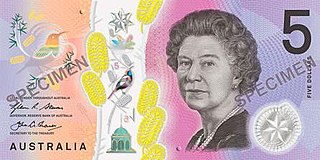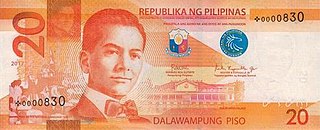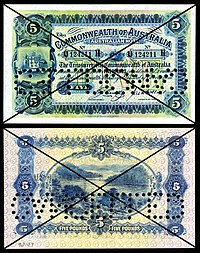The Kwacha is the currency of Zambia. It is subdivided into 100 Ngwee.

Clydesdale Bank is a trading name used by Clydesdale Bank plc for its retail banking operations in Scotland.

The United States five-dollar bill ($5) is a denomination of United States currency. The current $5 bill features U.S. president Abraham Lincoln and the Great Seal of the United States on the front and the Lincoln Memorial on the back. All $5 bills issued today are Federal Reserve Notes. As of December 2018, the average life of a $5 bill in circulation is 4.7 years before it is replaced due to wear. Approximately 6% of all paper currency produced by the U.S. Treasury's Bureau of Engraving and Printing in 2009 were $5 bills.

The Reserve Bank of Australia (RBA) is Australia's central bank and banknote issuing authority. It has had this role since 14 January 1960, when the Reserve Bank Act 1959 removed the central banking functions from the Commonwealth Bank.
The Irish Free State, subsequently known as Ireland, resolved in the mid-1920s to design its own coins and banknotes. Upon issuing the new currency, the Free State government pegged its value to the pound sterling. The Currency Act, 1927 was passed as a basis for creating banknotes and the "Saorstát pound" as the "standard unit of value." The legal tender notes issued under this act began circulating on 10 September 1928.
The Series B banknotes of Ireland replaced the Series A banknotes. The banknotes were issued between 1976 and 1992 by the Central Bank of Ireland, the series was replaced in 1993 by Series C banknotes.

The Australian twenty-dollar note was issued when the currency was changed from the Australian pound to the Australian dollar on 14 February 1966. It replaced the £10 note which had similar orange colouration. There have been only three different issues of this denomination: a paper note which had a gradient of yellow and red, with a distinct orange background, and two designs of polymer note which can be recognised for their distinct red-orange colouration. The first polymer note was issued on 31 October 1994 and the Next Generation polymer banknote was issued on 9 October 2019.

The Australian ten-dollar note was issued when the currency was changed from the Australian pound to the Australian dollar on 14 February 1966. It replaced the £5 note, which included the same blue colouration. There have been four different issues of this denomination: a paper banknote; a commemorative hi-polymer note, to celebrate the bicentennial of Australian settlement ; the 1993–2017 polymer note; and from September 2017 a polymer note featuring a transparent window.

The Australian one-hundred-dollar note was first issued in 1984 as a paper note. There have been two different issues of this denomination: initially a very light turquoise-blue paper note, and from May 1996, a green polymer note. Since the start of issue there have been six signature combinations. Two other combinations were not issued.

The Australian one-dollar note was introduced in 1966 due to decimalisation, to replace the 10-shilling note. The note was issued from its introduction in 1966 until its replacement by the one-dollar coin in 1984. Approximately 1.7 billion one-dollar notes were printed.

The 10/- banknote was first issued on 1 May 1913 as a blue banknote payable in gold. It was equal to a half sovereign gold coin. The sizes varied but the design was the same for the following issues: 1913–1914 issue was 194×83mm, 1915–1923 197×88 mm, 1923–1933 180×78mm. This issue was payable in gold but subsequent issues were legal tender.

The Australian five-dollar note was first issued on 29 May 1967 (Monday), fifteen months after the currency was changed from the pound to the dollar on 14 February 1966. It was a new denomination with mauve colouration – the pre-decimal system had no denomination with a value of £21⁄2. The first polymer version of the note was introduced in 1992. A major design update was issued from 1 September 2016, with a minor update to the signatures in 2019.

The Australian one-pound note was the most prevalent banknote in circulation with the pound series, with the last series of 1953–66 having 1,066 million banknotes printed. The first banknotes issued were superscribed notes purchased from 15 banks across Australia and printed with Australian Note and were payable in gold. Upon decimalisation in 1966, it was worth two dollars.

Banknotes of the euro, the common currency of the eurozone, have been in circulation since the first series was issued in 2002. They are issued by the national central banks of the Eurosystem or the European Central Bank. The euro was established in 1999, but "for the first three years it was an invisible currency, used for accounting purposes only, e.g. in electronic payments". In 2002, notes and coins began to circulate. The euro rapidly took over from the former national currencies and slowly expanded around the European Union.

The Australian ten-pound note was a denomination of the Australian pound that was equivalent to twenty dollars on 14 February 1966. This denomination along with all other pound denomination is still legal tender = twenty dollar note.

The Philippine twenty-peso note (₱20) is a denomination of Philippine currency. It is the smallest banknote denomination in general circulation in the Philippines. Philippine president Manuel L. Quezon is currently featured on the front side of the note, while the Banaue Rice Terraces and the Asian palm civet is featured on the reverse side.

The Philippine fifty-peso note (₱50) is a denomination of Philippine currency. Philippine president and former House Speaker Sergio Osmeña is currently featured on the front side of the bill, while the Taal Lake and the giant trevally are featured on the reverse side.

The Philippine one hundred-peso note (₱100) is a denomination of Philippine currency. Philippine president Manuel A. Roxas is currently featured on the front side of the bill, while the Mayon Volcano and the whale shark are featured on the reverse side.

The Philippine ten-peso note (₱10) was a denomination of Philippine currency. In its latest incarnation, Apolinario Mabini and Andrés Bonifacio are featured on the front side of the notes, while the Barasoain Church and a Blood Compact scene of the Katipuneros are featured on the reverse side. This banknote was circulated until the demonetization of the New Design Series on December 29, 2017. Its printing was stopped in 2001 and was replaced by coins.

The Bank of England £20 note is a sterling banknote. It is the second-highest denomination of banknote currently issued by the Bank of England. The current polymer note, first issued on 20 February 2020, bears the image of Queen Elizabeth II on the obverse and the image of painter J. M. W. Turner on the reverse. It replaced the cotton paper note featuring a portrait of economist Adam Smith, first issued in 2007.

















